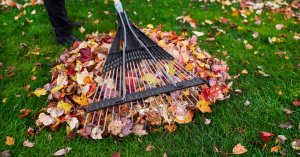Welcome to the Landscape Networker’s Guide to Evergreen Bushes, Shrubs, and Trees. If you’re a DIY’er, this guide is perfect for you because it will cover the 12 tips that you need to know to maintain your property’s evergreen bushes, shrubs, and trees.
If you want further information on taking care of your evergreen woody plants, go to my YouTube channel for more hands-on techniques. Here are three videos to get you started:
- Why Are My Arborvitae Brown?
- Why Are My Boxwoods Brown?
- What Are Bagworms and How Do I Get Rid of Them?
Now, here are the 12 tips that you need to know in order to take the best care of your evergreen bushes, shrubs, and trees throughout the entire year:
- You need to regularly inspect your evergreen bushes, shrubs, and trees for insects and disease. In most cases, you’ll be able to bring your evergreen bushes, shrubs and trees back to full health when you catch insects and diseases early. In the beginning of spring to mid-spring, it’s a good idea to take a walk around your property, inspecting your woody evergreens for insect, disease, and winter damage. Throughout the growing season, keep taking periodic walks throughout your property checking for insect and disease damage.
Here Are Some Typical Symptoms Of Disease Or Insect Infestation:
- Brown leaves
- Discolored leaves
- Leaf blisters
- Defoliage
- Dieback.
- Make sure that you buy the right plant for the right place on your property. Know how big and wide your new bushes, shrubs and trees will be at full growth. Then plot where they should go in your beds, borders, and yard. You don’t want to put a tree or a shrub in a bed that will outgrow its space within five years. Instead, you want to know how big and wide it’ll get within three to five years, and put it at a spot where it will grow to its full size and still look like it belongs in the landscape.
Also, if you decide to transplant your evergreens, make sure that the new spot you pick for the transplant provides the right amount of light and space for the shrub or tree to grow to its full height. Take care as you dig out the bush or tree making sure that you dig wide enough to avoid breaking any of the roots in the tree’s zone. For in-depth steps to help you transplant your evergreen bushes and shrubs, go to this Clemson University Extension article, http://goo.gl/PS5cxI.
- Take care of your evergreens. These woody plants need the same basic care that other plants need. When evergreen trees, shrubs and bushes have the right amount of light, water and fertilization, they’ll be able to ward off disease (some of these tips will be covered in more detail later in this guide):
-
- Sunlight – All plants need light. Make sure you’re planting an evergreen based on its light needs—partial shade/sunlight, full sun, etc.
- Water – Make sure your evergreens get the right amount of water. You should continue watering your evergreens into late fall so they have enough moisture stored in their leaves and roots to survive a tough winter.
- Soil – All plant life needs healthy soil. Make sure that your soil has the right drainage, nutrients and pH needed for your evergreens to survive and thrive.
- Fertilizer – Use the right fertilizer in the right amount at the right time of year to give your evergreens the food they need to stay healthy.
- Protection from winter damage – In late fall, you have some options to consider before putting your evergreens to bed for the winter.
- Protection from disease and insects – You want to inspect your evergreens for leafminer, blight, bagworms and other diseases and insects that could kill your evergreens. Additionally, consider investing in new cultivars that are more disease- and insect-resistant.
- Prune your evergreens – Fortunately, you don’t have to do a lot of pruning on your evergreens. When you do prune, your goal should be to help them keep their form and to keep them beautiful and healthy.
- Buy your evergreen bushes, shrubs and trees at reputable garden centers and nurseries. Know where your plants come from. Locally grown evergreen stock can handle your area’s freeze/thaw cycles, dry periods, and other issues that are unique to your region. Don’t be afraid to ask your garden center or nursery questions about the best way to care for your plants. And ask about plant warranties and guarantees to protect your investment should your evergreens die within the first three to five years.
- Be an expert on your property’s evergreens. Know what is planted and where. Know what each woody plant needs in order to stay healthy and thrive in your landscape.
- Get your soil tested before you fertilize. Prior to fertilizing, you need to know what nutrients are missing and the only way you’ll be able to do that is through a soil test. You can get a soil test through your state’s cooperative extension office. They’ll be able to guide you in the process of obtaining soil and sending it to them for testing.
- Additionally, you need to know the pH of your soil. Some evergreens do well in very acidic soil while others would grow best in slightly acidic soil. Your soil test should also tell you the pH level of soil.
- Buy the right fertilizer for your woody plants. After you receive the results of your soil test, you’ll know exactly what nutrients are missing. Even if your shrubs and trees are in the middle of your yard, they’ll still need fertilizer that is made specifically for their species. You have a choice of fertilizer methods:
-
- Deep root feeding to help get an evergreen back to health.
- Liquid fertilizer that’s drenched around the plant’s root zone. This video shows how I fertilized a blue atlas cedar using the drenching method.
- Spikes that you can place in the root zone of your evergreen.
You can find these different types of fertilizers at your local garden center or big box store. By checking the back of the package, you’ll see how much nitrogen, potassium and phosphorous are in the fertilizer. Make sure that you buy the fertilizer with the right amount of nutrients to add to your soil. Make sure that you read and follow all of the instructions at the bag of the fertilizer bag or container.
The University of Minnesota has an excellent article focused on fertilizing evergreens at http://goo.gl/iKrhYM.
- Prune your evergreens to keep them healthy. Fortunately, evergreens need very little pruning to maintain their beauty and vitality.
-
- Spruces, firs, and Douglas firs don’t continue to grow. Yet, you may want to prune back their side buds that sprout. Late winter pruning is the best time for pruning these types of conifers.
- Pines really don’t need pruning. However, if you want a denser evergreen, prune up to 2/3 off of new candles and don’t cut back past the current’s season’s new growth.
- You can prune arborvitae, junipers, yews and hemlocks since they continue to grow throughout the spring and summer. You can prune them from late winter through mid-summer. Your purpose in pruning should be to correct any growth defects.
- For more specifics in best pruning practices and tools, go to the University of Minnesota Extension, http://goo.gl/WhLxiw.
Invest in deer resistant evergreens. No evergreen or any other plant is 100% safe from deer eating them because deer will eat anything if food is scarce. If you want to be 100% sure that deer won’t eat your landscape plants, you can erect a perimeter fence or wrap your evergreens to protect them from hungry deer. You can also plant these suggested evergreens that are deer resistant:
- Barberry (Berberis sp.)
- Boxwood (Buxus)
- Japanese Plum Yew (Cephalotaxus harringtonia)
- American holly (Ilex opaca) and other holly varieties
- Juniper (Juniperus horizomalis)
- Russian Cypress (Microbiota decussia)
- Japanese Pieris, Andromeda (Pieris japonica)
- Sweet Box (Sarcococcoa hookeriana)
- Arrowwood Viburnum (Viburnum dentatum).
For an in-depth list on deer-resistant shrubs and other plants, go to Rutger University’s list of deer-resistant plants, https://goo.gl/ZN1rAf.
- Protect your evergreen shrubs and bushes with burlap wraps or anti-desiccants. Winter winds deplete your evergreens’ water supply pretty quickly. In order to avoid winter burn and other damage from harsh winter winds, storms and Arctic temperatures, you can wrap your evergreens in burlap that you can purchase at any garden center or big box store that sells landscape products. Make sure that you follow the instructions including using three poles to keep the burlap in place without rubbing up against the shrub.
If you choose not to use burlap wrap, you can spray your evergreen shrubs and trees with an anti-desiccant spray in late fall. The anti-desiccant spray adds a waxy protective coating on the shrubs to protect them from winter burn. Broadleaf evergreens and conifers are top picks for this type of protection.
- Be aware of the popular pests that may attack your evergreens:
- Leafminer – Leafminers are tiny orange worm-like critters that eat the leaves of your boxwoods from the inside out. Your boxwood’s leaves may develop blisters. To see leafminers in action, watch this video.
A horticultural insecticide with acephate will help rid leafminers at the larval stage. If you see eggs hatching, you can use an insecticide that contains carbaryl, neem, or pyrethrin to help rid your boxwoods from leafminers. Plus, you’ll want to make sure that you fertilize your infected boxwoods to help them grow new leaves and bring them back to vitality.
- Boxwood blight – Boxwood blight is a fungus that kills boxwoods and woody plants in the boxwood (Buxus) family. It’s highly contagious and can be spread to other boxwoods through spores that attach to garden tools and clothing. Your boxwoods may have blight if the leaves develop brown spots and there’s black streaking on the stems.
To prevent boxwood blight, you can buy fungicides that will need to be reapplied every 7-14 days. If you have infected boxwoods, dig them out, including the topsoil that covered the roots, and dispose of them through your trash service. Once a boxwood contracts blight, there is no cure for the disease.
To ensure that you don’t buy boxwoods susceptible to blight, you can buy partially- to most resistant boxwoods. Make sure that you buy your boxwoods from a nursery or garden center that sells stock that is blight-free.
Ask your nursery or garden center where they get their boxwood stock from and if it came from a blight-free grower.
- Bagworms – These critters are caterpillars that will later turn into moths. They will eat your evergreen’s foliage and then pupate. In spring, you’ll notice them in the larval stage where you’ll find webbed bags hanging from your evergreens. You can see what bagworms look like in this video.
Insecticides will not penetrate these sacks. Females lay their eggs in the fall. Thus, you can inspect your evergreens in the early fall for small bags and pick them off by hand. Also, you can use btk (bacillus thuringiensis kurstaki), a bacteria treatment that will target the caterpillars but won’t harm any nearby beneficial insects.
- Southern red spider mites – Hollies seem to be more susceptible to southern red spider mites compared to other evergreen shrubs. These mites are closely related to spiders and are 1/50th inch in size. They use their sucking mouth parts to feed on leaves’ undersides. You may notice light yellow speckling on leaves that will eventually turn reddish brown in color and will drop off the shrub. In the early spring, you can check for red spider mites by inspecting your holly bushes’ leaves on their undersides or by shaking a holly branch over a piece of white paper. Some methods of ridding spider mites include insecticide soap sprays that contain horticultural oil, bifenthrin and acephate. You can buy insecticide soap sprays at your local garden center or big box store.
I hope that these 12 tips will help you keep your evergreen bushes, shrubs and trees healthy on your property. One final tip: Make sure that you follow all instructions on fertilizers and pesticides, including correct storage, to keep you and your family healthy and safe.
If you have specific questions regarding the care and feeding of your evergreen plants, please call me at 973-476-4863 or fill out my contact form.
——————-
Sources:
Better Homes and Gardens. “Stop Leafminers,” http://www.bhg.com/gardening/pests/insects-diseases-weeds/stop-leafminers.
Brown, Deborah. “Yard and Garden: Fertilizing Evergreens (Conifers), University of Minnesota Extension: http://www.extension.umn.edu/garden/yard-garden/trees-shrubs/fertilizing-evergreens-conifers.
Bush, Elizabeth, et. al. “Best Management Practices for Boxwood Blight,” Virginia Cooperative Extension: http://pubs.ext.vt.edu/PPWS/PPWS-29/PPWS-29.html.
Cranshaw, W.S. and B. Baxendale. “Insect Control: Horticultural Oils,” Colorado State University Extension: http://www.ext.colostate.edu/pubs/insect/05569.html.
Dana, Michael, N. “Fertilizing Woody Plants,” Purdue University Cooperative Extension Service: Dept. of Horticulture: http://goo.gl/MdCsRu.
Hoover, Gregory, A. “Boxwood Leafminer,” PSU Ext: http://ento.psu.edu/extension/factsheets/boxwood-leafminer.
Land Design Network. Various videos, https://www.youtube.com/channel/UC82jYc978yQtHBpMgSbfq2Q.
Nitzche, Pete, et. al. “Landscape Plants Rated by Deer Resistance,” Rutgers University: https://njaes.rutgers.edu/deerresistance.
Penn State Extension. “Control Bagworms before It’s Too Late!” Penn State Extension: http://extension.psu.edu/juniata/news/2013/control-bagworms-before-its-too-late.
Shaughnessy, Debbie. “Transplanting Established Trees & Shrubs,” Clemson University Cooperative Extension: http://www.clemson.edu/extension/hgic/plants/landscape/shrubs/hgic1055.html.
University of Massachusetts. “Q & A: Protecting Landscape Plants in the Winter,” https://extension.umass.edu/landscape/news/qa-protecting-landscape-plants-winter.
Williamson, Joey. “Holly Diseases and Insect Pests,” Clemson University Cooperative Extension: http://www.clemson.edu/extension/hgic/pests/plant_pests/shrubs/hgic2055.html.
Zins, Mike and Deborah Brown. “Pruning Trees and Shrubs,” University of Minnesota Extension: http://www.extension.umn.edu/garden/yard-garden/trees-shrubs/pruning-trees-shrubs.



